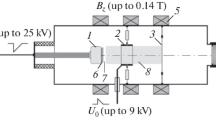Abstract
We report on results of investigation into the structure of a plasma jet generated by a coaxial plasma accelerator with conical insert in the discharge formation region. Using high-speed optoelectronic camera, we detected an inhomogeneous structure of glowing fractions of argon and deuterium jets. It was found that the jet radiation intensity oscillates with a characteristic frequency of 0.3–0.9 MHz. The argon plasma jet consisted of fragments diverging from the axis; plasma recombined 20 μs after the beginning of the discharge. The deuterium plasma jet resembled flakes. Its radiation intensity decreased significantly by 8 μs. The characteristic frequencies of radiation nonuniformities on the jet axis were about 0.09 cm–1 for argon and 0.3 cm–1 for deuterium. Analysis of the behavior of the discharge in the plasma accelerator revealed that a diffuse discharge was initiated at the base of the conical insert. After 0.5 μs, the discharge emerged at the outer boundary of the insert, was contracted, and occurred between central and external electrodes. The emergence of the discharge from the accelerator was observed 3 μs later and was accompanied with a glow of the end face of the central electrode. In the measurements of temperature of the lateral surface of external electrode using an infrared camera, it was found that heating is localized near the edge of conical insert and at the outlet of the accelerator. Results of investigations can be used for gas ionization, material irradiation, and simulation of interaction of plasma flows with the magnetic field in the outer space in laboratory conditions.









Similar content being viewed by others
REFERENCES
M. Viktorov, S. Golubev, and A. Vodopyanov, Plasma Phys. Controlled Fusion 61, 035001 (2019).
S. C. Hsu and P. M. Bellan, Mon. Not. R. Astron. Soc. 334 (2), 257 (2002). https://doi.org/10.1046/j.1365-8711.2002.05422.x
S. Y. Gunsu, Y. Setthivoine, and P. M. Bellan, Nucl. Fusion 47 (3), 181 (2007).
A. V. Ankundinov, A. V. Voronin, V. K. Gusev, Ya. A. Gerasimenko, E. V. Demina, M. D. Prusakova, and Yu. V. Sud’enkov, Tech. Phys. 59 (3), 346 (2014). https://doi.org/10.1134/S1063784214030025
H. Alfven, L. Lindberg, and P. Mitlid, J. Nucl. Energy, Part C 1, 116 (1960).
J. Wiechula, C. Hock, M. Iberler, T. Manegold, A. Schonlein, and J. Jacoby, Phys. Plasmas 22, 043516 (2015).
A. V. Voronin, V. Yu. Goryainov, and V. K. Gusev, Tech. Phys. 65 (6), 987 (2020). https://doi.org/10.1134/S1063784220060286
A. V. Voronin, V. K. Gusev, E. V. Demina, G. S. Kurskiev, V. B. Minaev, A. N. Novokhatskii, Yu. V. Petrov, N. V. Sakharov, Yu. V. Sud’enkov, and S. Yu. Tolstyakov, in Physico-Chemical Aspects of Extreme States and Structural Transformations in Continuous Media, Materials and Technical Systems, Ed. by Yu. V. Petrov (Politekhnika, St. Petersburg, 2017), Vol. 1, p. 110 [in Russian].
Physical Encyclopedic Dictionary, Ed. by A. V. Prokhorov (Sov. Entsiklopediya, Moscow, 1983) [in Russian].
ACKNOWLEDGMENTS
The experimental stand for testing the plasma gun was constructed and maintained by the Ioffe.
Funding
The experimental sample of the coaxial plasma jet accelerator was fabricated and tested under the agreement with the Ministry of Science and Higher Education of the Russian Federation (project identifier RFMEFI58519X0007). This study was supported by the Russian Foundation for Basic Research (project no. 18-29-21037), the Ministry of Science and Higher Education of the Russian Federation under the State assignment in science (project no. 0784-2020-0020).
Author information
Authors and Affiliations
Corresponding author
Ethics declarations
The authors declare that they have no conflicts of interest.
Additional information
Translated by N. Wadhwa
Rights and permissions
About this article
Cite this article
Goryainov, V.Y., Viktorov, M.E., Vodop’yanov, A.V. et al. Peculiarities of the Discharge Formation in a Plasma Accelerator and Structure of a Jet Flowing into Vacuum. Tech. Phys. 66, 325–332 (2021). https://doi.org/10.1134/S1063784221020134
Received:
Revised:
Accepted:
Published:
Issue Date:
DOI: https://doi.org/10.1134/S1063784221020134



